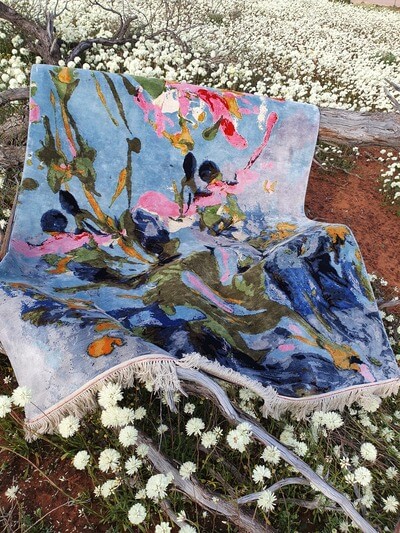At Germany’s Carpet Design Awards this year, Perth artist Dena Lawrence won the ‘Best Studio Artist Design’ category.
Her winning piece, which she calls Maschera, is an extraordinary silk rug – woven by artisans in Kashmir.
“Being able to collaborate with the skilled artisans in Kashmir and witness my designs transform into exquisite hand-woven rugs was a rewarding experience beyond words,” she tells Indian Link. “It not only celebrated their craftsmanship but also highlighted the beauty and artistry of Kashmiri weaving traditions to a broader audience.”

The composition in Maschera is as luxurious as it is intricate. Crafted from 100% silk, every fibre exudes elegance and sophistication. The meticulous detailing of 484 knots per square inch creates a mesmerising interplay of colours, adding depth and texture to the rug’s surface.
“Running your fingers over its surface is an experience in tactile artistry,” Lawrence shares.
She calls this collaboration with the Kashmiri weavers “a testament to the power of creativity”.
Dena Lawrence: The Kashmir connection
At home in Perth, Dena Lawrence’s brush strokes draw inspiration from wildflowers and seascapes. Her artworks are a free expression of her feelings; she uses art to break habitual behaviour, explore light and dark, and celebrate the beauty of nature.
Most importantly, however, her art also soothes in difficult times.
For this, she credits her long connection with Kashmir – adorned with beauty yet veiled in sorrow.

Lawrence’s enduring bond with Kashmir began as a tourist in 2009. She was already an accomplished artist in Perth, with her primary focus capturing Australia’s vibrant hues and landscapes. “I was profoundly moved by Kashmir’s duality — the breathtaking beauty (Perfume) and the visible trauma and grief resulting from years of military insurgency and conflict (Poison).”
Having specialised in post-traumatic stress syndrome, she decided to initiate a self-funded art programme to provide support to the youth in Srinagar.
“This programme involved adapting the art therapy model I had previously developed in a private psychiatric hospital in Perth, to address the unique needs of the youth in Kashmir,” she explains. “Over three years, I conducted workshops for students at the University of Kashmir, with a specific focus on training 15 students to delve deeper into the art therapy process. The goal was to empower them to extend their knowledge and skills to others within their community, creating a ripple effect of healing and support.”
Before this art programme, in 2010, Lawrence had put her successful experience as an artist in Australia to good use in India. She had had her artwork printed on scarves and shawls there, for sale in Australia. But the course of her art journey truly changed in 2013 after she wrapped up the healing program in Kashmir.

This was when Lawrence had the chance to meet some incredible artisans and weavers in the Valley. The idea then struck her to take her artwork beyond scarves and shawls, by translating her designs into stunning silk rugs to support Kashmir’s declining weaving industry.
“It felt like a natural progression — from assisting the youth in Kashmir with trauma through art therapy to leveraging my creative strengths and simultaneously engaging the skilled weavers in Kashmir in what they excel at meticulous and delicate weaving.”
Preserving Kashmir’s rich weaving heritage
Before the onset of armed insurgency in the 1990s, Kashmir had more than 100,000 carpet weavers. However, three-quarters of them switched to street vending or driving auto rickshaws to survive during some of the darkest days in Kashmir’s longstanding carpet industry.
Moved by the plight of these skilled artisans, Lawrence pledged to help. “Through the Dena Lawrence Firesun Collection, I provided valuable work for the weavers of Srinagar, offering better working conditions and higher wages than those widely available.”

Every Dena Lawrence Firesun Collection rug uses 22 to 40 colours woven in a high density with 576 knots per square inch. Using symmetric and asymmetric knots facilitates an accurate replication of the painting.
“The lustre of pure silk adds a reflective glimmer that changes seasonally throughout the day, depending on the light,” she explains.
Initially, her free-flowing abstract works were a challenge for the Kashmiri weavers, who are more accustomed to traditional Persian rug designs with repeating patterns.
“The best master weavers in Srinagar were employed for the project. Their expertise enabled a successful merging of expressionist modern art from Australia with the timeless technique of hand-knotted rugs to create something completely unique.”
How are these rugs unique, we ask.
“Kashmir pure silk carpets are regarded as among the finest handmade rugs in the world, known for their beauty and strength,” she replies. “The tightly-packed, intricate knots make the rugs durable, and this structural integrity allows the subtle tonal shifts of my paintings to be replicated and enhanced in woven form.”

She beams, “Knotted in silk, they glow like gemstones or stained glass.”
Each carpet takes six to nine months to weave. Lawrence translates her artwork into a digital image and sends them over to the carpet designer in Srinagar to translate them into rugs.
Art for harmony as well as vitality
“Embracing creativity and exploring innovative approaches to art is integral to my personality — I thrive on challenges and enjoy venturing into new territories,” she smiles. “Adapting my artistic practice to rug designs was born from a desire to see my vibrant and dynamic art take on new life in a different medium.”
After she secured the top position at the Carpet Design Awards 2024, Lawrence took to Facebook to thank the Kashmiri weavers behind her winning design.
“Magic,” she called it.
Dena Lawrence’s rugs continue her search for harmony and vitality through art.
READ ALSO: Aboriginal designs for your sari




